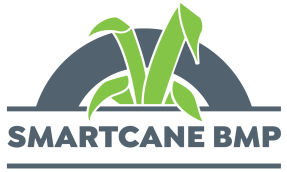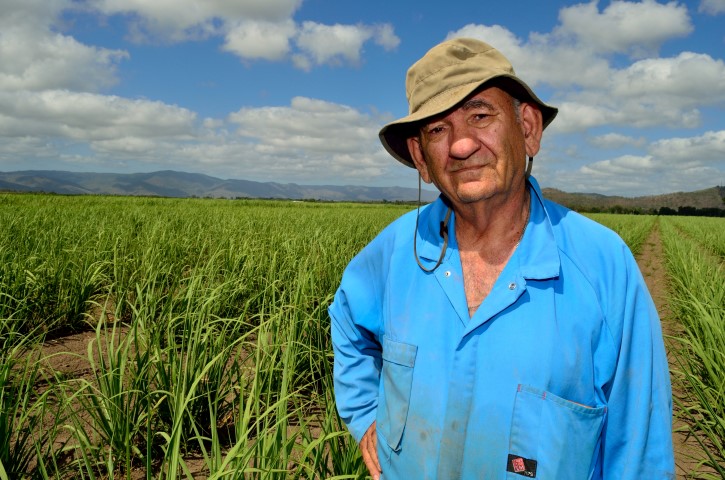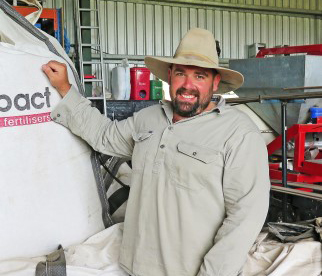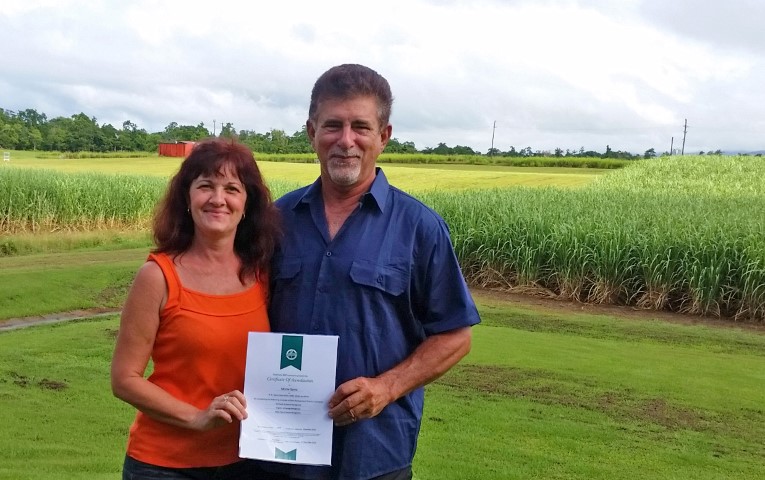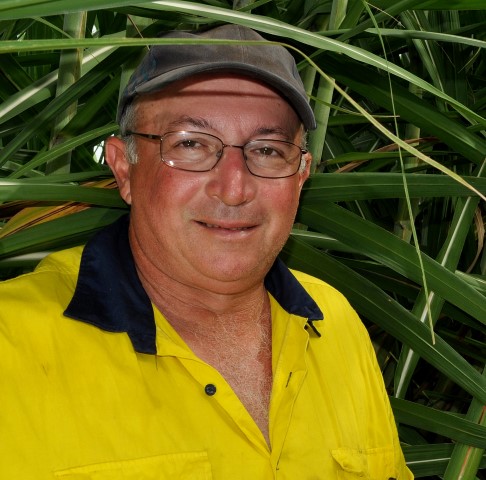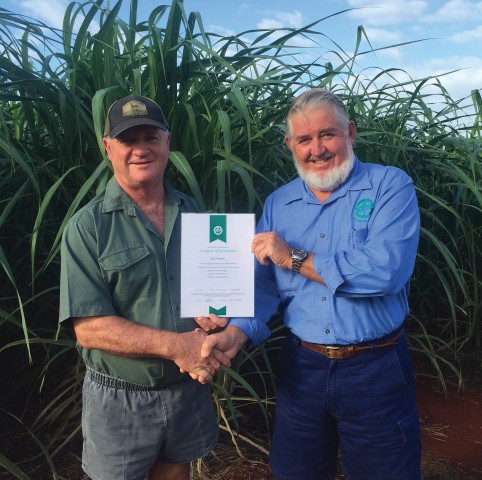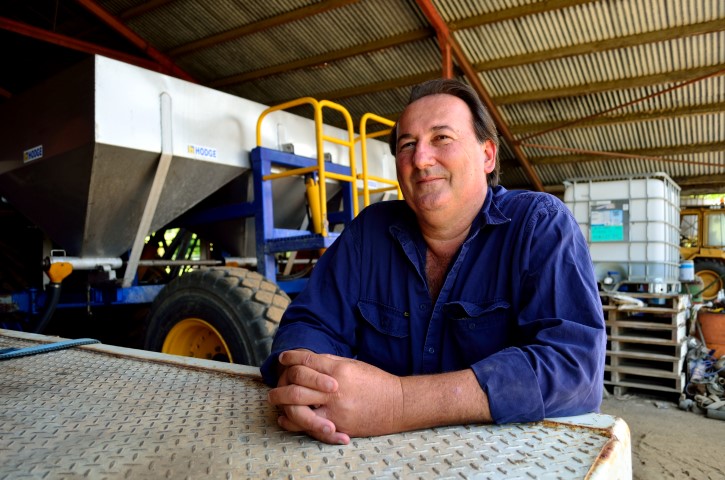Herbert River district grower Frank Russo believes he’s defied industry critics who labelled cane farmers ‘dinosaurs’ by gaining best practice accreditation in the three core modules of Smartcane BMP.
As Frank recalls, it all began with a visiting public servant from a government department once telling “dinosaur” cane farmers in the Ingham region to change or, “get out of the industry”.
That comment motivated him to prove he was not only up for the challenge of achieving best practice but also that a lot of what he’d been doing for a long time was already hitting the mark.
“I had to do it just to prove that I was not a dinosaur and even the old dinosaurs can comply with all the new rules and regulations,” Frank said.
“We have been laser levelling for years, we already make spoon drains. We already trash blanket, we already zero till. We are already doing it.”
He says the progressive shift to green cane harvesting in the Ingham district, which started 30 years ago, is an example of how the industry has worked to deliver improved environmental outcomes.
“Because of the mulching, conserving moisture and all the benefits that go with green cane, you don’t cultivate so you don’t get erosion, you don’t get soil runoff plus the trash rots and breaks down and becomes a nutrient,” he said.
There’s an obvious parallel with the current emphasis on keeping agricultural inputs on farm. As Frank sees things, a steady, progressive shift to improved practices in nutrient, chemical and sediment management will benefit both the environment and the farmer’s bottom line.
“Our two biggest expenses outside of harvesting on our farms is chemical and fertiliser,” he said. “We want to use the minimum amount that we need to grow our crop and we want it to stay on our farm.” The Smartcane BMP program has been crafted so as not to be prescriptive, which suits Frank. He tried controlled traffic farming on a dual row 1.8 metre spacing 20 years ago but didn’t achieve productivity gains over a full growing cycle.
Frank uses a minimal till system, most machinery wheel tracks are set to match the row spacing and equipment is operated under GPS guidance. It ticks the Smartcane BMP boxes for minimising compaction and tillage management.
Frank was thankful for the assistance of Herbert River Smartcane BMP facilitator Maria Battoraro in helping collect the information and records he needed to secure accreditation.
Frank would rather live without any form of regulation, be it industry driven or enforced regulation but in the absence of a choice, his message to fellow growers is that if a ‘dinosaur’ can become Smartcane BMP accredited, so can they.
“The only thing that a lot of my fellow growers have got to start to understand is that the rules are there whether we like it or not and I don’t like it as much as the next bloke,” Frank said. “But at the end of the day I don’t think they’re going to change them in a hurry.
“We haven’t got a choice to say whether we comply or not because the gun’s been put at our head with a live round in it and it’s been cocked.
“To stay Smartcane BMP accredited, the way we are now, is the best.”
As Frank recalls, it all began with a visiting public servant from a government department once telling “dinosaur” cane farmers in the Ingham region to change or, “get out of the industry”.
That comment motivated him to prove he was not only up for the challenge of achieving best practice but also that a lot of what he’d been doing for a long time was already hitting the mark.
“I had to do it just to prove that I was not a dinosaur and even the old dinosaurs can comply with all the new rules and regulations,” Frank said.
“We have been laser levelling for years, we already make spoon drains. We already trash blanket, we already zero till. We are already doing it.”
He says the progressive shift to green cane harvesting in the Ingham district, which started 30 years ago, is an example of how the industry has worked to deliver improved environmental outcomes.
“Because of the mulching, conserving moisture and all the benefits that go with green cane, you don’t cultivate so you don’t get erosion, you don’t get soil runoff plus the trash rots and breaks down and becomes a nutrient,” he said.
There’s an obvious parallel with the current emphasis on keeping agricultural inputs on farm. As Frank sees things, a steady, progressive shift to improved practices in nutrient, chemical and sediment management will benefit both the environment and the farmer’s bottom line.
“Our two biggest expenses outside of harvesting on our farms is chemical and fertiliser,” he said. “We want to use the minimum amount that we need to grow our crop and we want it to stay on our farm.” The Smartcane BMP program has been crafted so as not to be prescriptive, which suits Frank. He tried controlled traffic farming on a dual row 1.8 metre spacing 20 years ago but didn’t achieve productivity gains over a full growing cycle.
Frank uses a minimal till system, most machinery wheel tracks are set to match the row spacing and equipment is operated under GPS guidance. It ticks the Smartcane BMP boxes for minimising compaction and tillage management.
Frank was thankful for the assistance of Herbert River Smartcane BMP facilitator Maria Battoraro in helping collect the information and records he needed to secure accreditation.
Frank would rather live without any form of regulation, be it industry driven or enforced regulation but in the absence of a choice, his message to fellow growers is that if a ‘dinosaur’ can become Smartcane BMP accredited, so can they.
“The only thing that a lot of my fellow growers have got to start to understand is that the rules are there whether we like it or not and I don’t like it as much as the next bloke,” Frank said. “But at the end of the day I don’t think they’re going to change them in a hurry.
“We haven’t got a choice to say whether we comply or not because the gun’s been put at our head with a live round in it and it’s been cocked.
“To stay Smartcane BMP accredited, the way we are now, is the best.”
